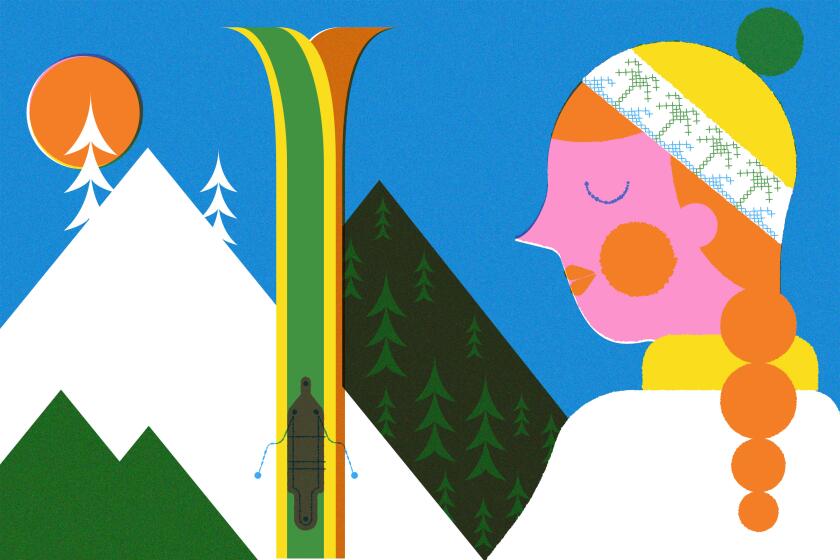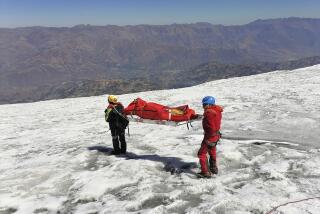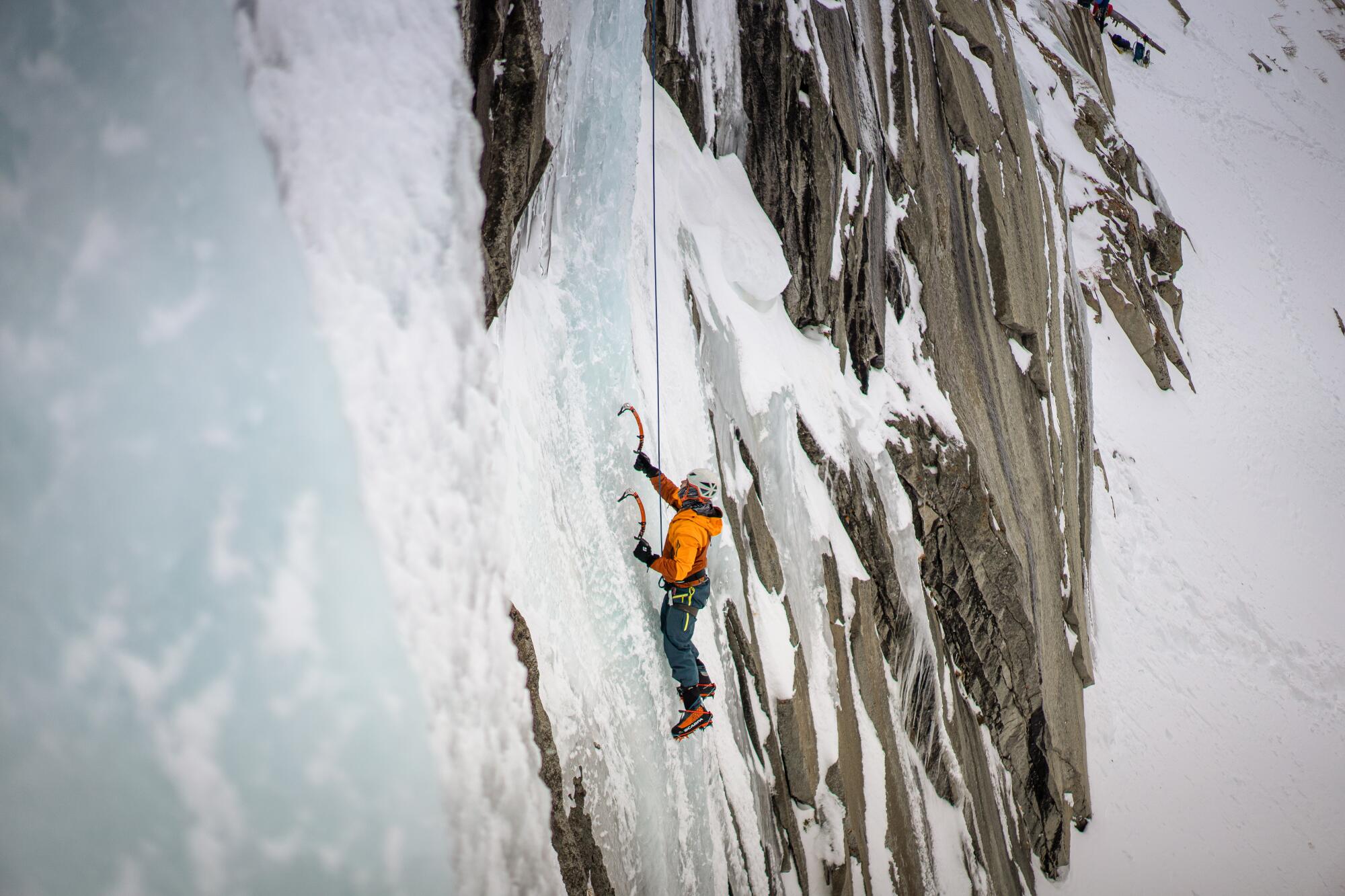
Thwack! Thwack! Thud!
Oh, thank God, my whole body exclaimed. After a few swings, the razor-sharp pick I clutched lodged firmly into a cascading frozen waterfall. Shards of ice exploded from the point of contact onto my face. A taste of blood. At least the hold seemed solid. I raised one foot and kicked the tippy-toe spike of a traction device attached to my boot into the opalescent surface. Then I raised the other.
Like a cat walking on extended claws, I made my way up Chouinard Falls in Lee Vining Canyon, an ice-climbing mecca in the state. Swing, crash, thud. Two steps. Swing, crash, thud. Two steps.
I wasn’t fast. I definitely wasn’t graceful. But I was ice climbing.
Joshua Tree, Palm Springs, San Diego, Mammoth Mountain, Lake Tahoe, Idyllwild. Here’s a list of things to do this winter.
Ice climbing, as the name suggests, entails scaling frozen water. Even mountain goats can’t scramble up vertical ice, so specialized equipment is needed. Like rock climbing, the sport entails a rope system — known as belaying — but differs in substantive ways.
Not only does ice-climbing gear resemble medieval torture devices, but the sport, for obvious reasons, must be done in the cold. Ice forms in the shade, adding to the chill factor. Particularly frigid climbs can bring on the “screaming barfies,” a cluster of symptoms that include severe hand pain and nausea. (My sun-soaked Angeleno blood curdles at the thought.) As climbers chop into the ice with their tools and crampons, frozen debris rains below.
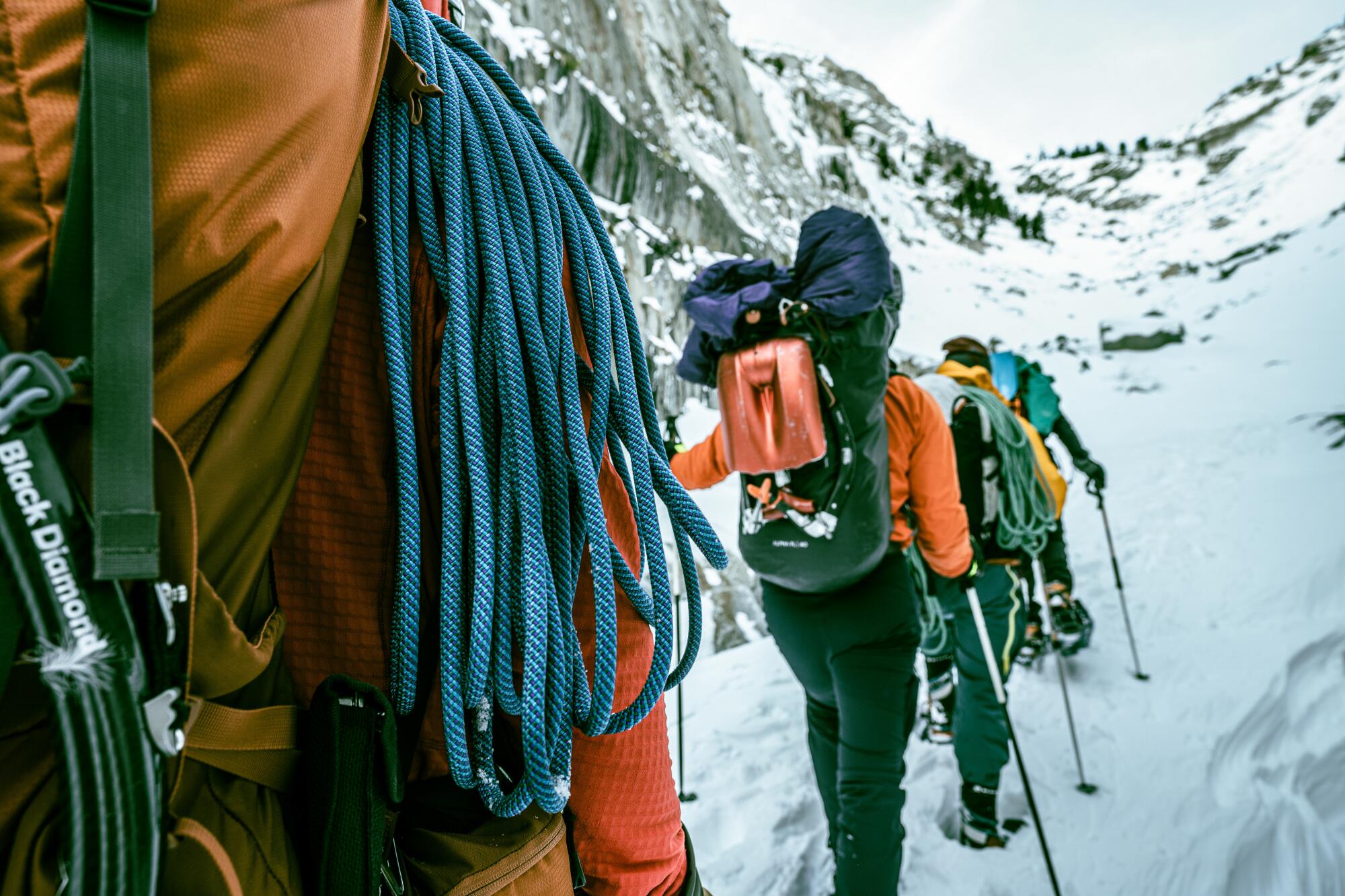
While it is still relatively obscure, several mountain guides said ice climbing has received a nudge closer to the mainstream with the explosion of outdoor recreation in recent years. Roughly 2.5 million Americans climb ice or rock or pursue mountaineering, up nearly 18% from the mid-2000s, according to the Outdoor Industry Assn., a collective that includes business leaders, climate experts and policy makers.
“Before I tried it, I always had this idea that it was the craziest thing you could do,” said Michael O’Connor of Sierra Mountain Guides. “I was, like, does the ice just fall down and hit you? And, yeah, the equipment seems cool, but it also seems horrifying.”
Yet O’Connor came away from his first tussle with ice, around 2010, wanting more.
Now, “By the time fall is hitting and I see the ice starting to form up and start to hear about people climbing on things, I’m like, ‘All right, I’m getting kind of psyched.’ And then once it’s here in Sierra, I’m like, ‘Let’s go.’ And it’s so fun.”
A guide to what’s new at Mammoth, Big Bear, Tahoe and other ski resorts across the state for the 2023-2024 season.
Sunny California, ice climbing’s unlikely birthplace
Conquerors of big mountains have long contended with ice. Once upon a time, alpinists laboriously hacked steps into it — literal stairways to heaven. That all changed in the mid-1960s to early 1970s. Renowned climber Yvon Chouinard — who set up a blacksmith shop in Ventura and later opened outdoor clothing brand Patagonia’s first store nearby — developed a curved pick that could claw into steep ice and stay put. Early climbs using the innovative tool were made in California’s Eastern Sierra Nevada.
“It’s no stretch to call that the ice-climbing revolution,” said Doug Robinson, who frequently climbed with Chouinard in those days and helped usher in the sport’s transformation.
Climbers began to haul themselves up frozen waterfalls and dangling icicles, carving out a discipline separate from mountaineering. Sunny California, far from the epicenter of the sport today, can broadly be considered the cradle of its modern form.
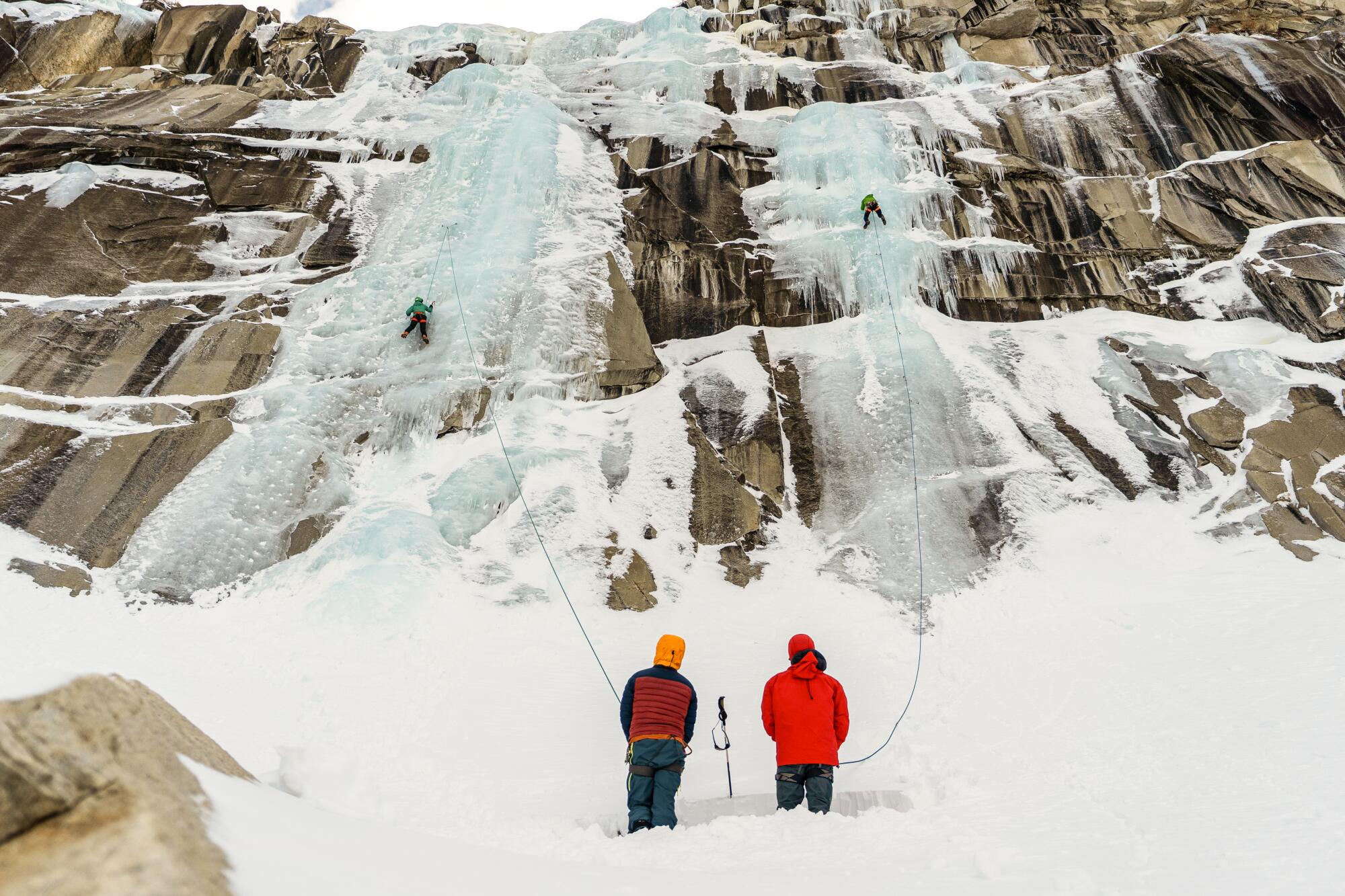
The allure of ice climbing
Ice fanatics and detractors alike speak reverentially of its ephemeral quality. (The qualifier is so intertwined with the practice that a recent Instagram post I came across read, “This is a generic ice climbing post… ephemeral ephemeral ephemeral ephemeral ephemeral…”)
Unlike rock, ice is constantly changing. It can form, melt and re-form multiple times a season — and exactly how it manifests is different each time. Depending on the climber, this presents an interesting puzzle or infuriating challenge.
Adrian Ballinger, owner of Lake Tahoe-based guiding company Alpenglow Expeditions, highlighted the creative movement the malleable surface permits.
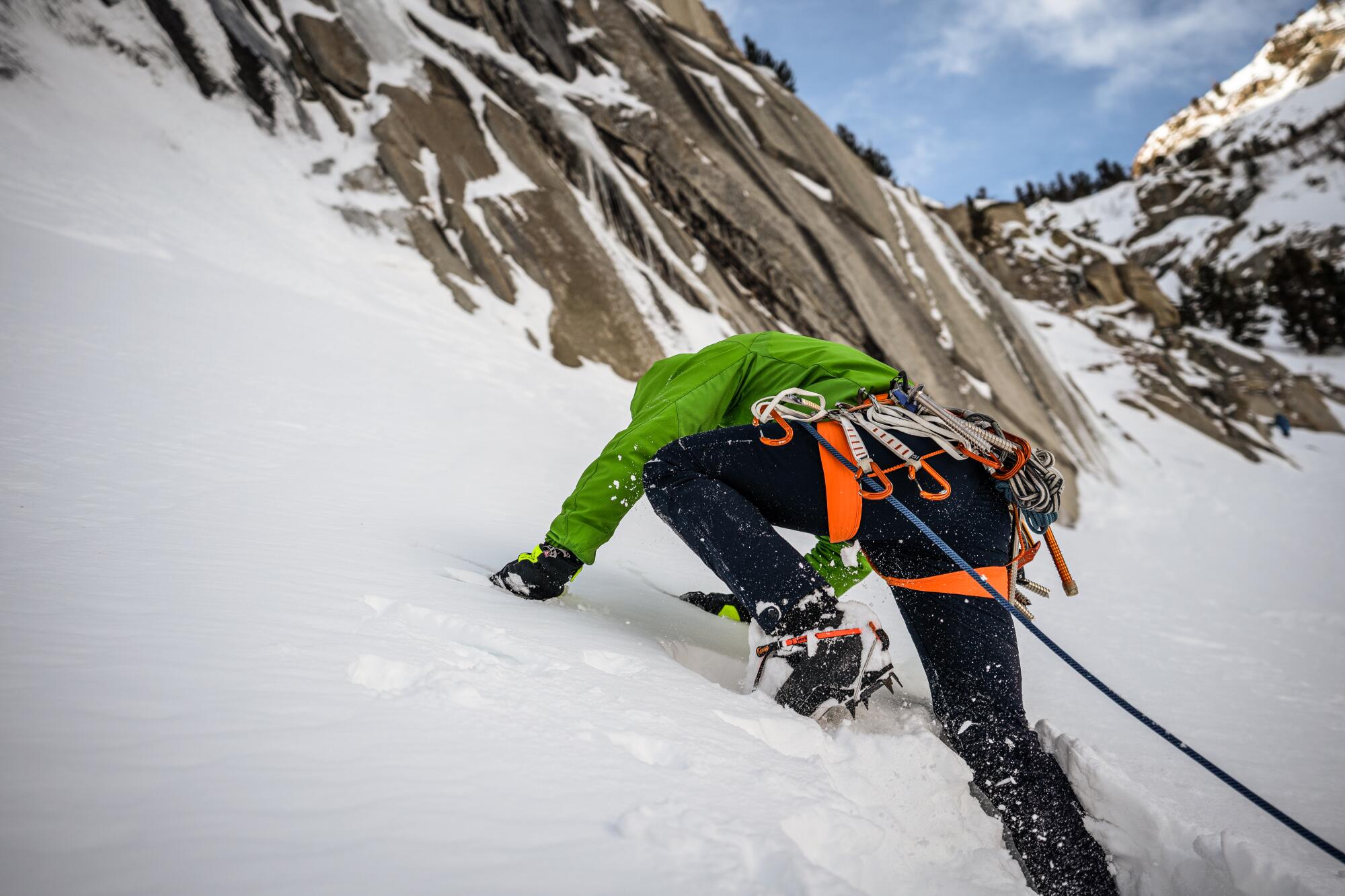
In rock climbing, “Whether you’re outside or in the gym, there are a certain number of places where you can put your hands and feet and that’s it,” Ballinger said. “The beauty of ice is since you have these spikes on your feet and in your hands, you can make your handholds and footholds anywhere you choose.”
The same principle makes it accessible to a range of body types, he added. While one rock climb might be better or worse for a short person, ice allows people of all shapes to forge their own path.
Then there’s just the badassery of pursuing an activity that epitomizes radical.
Ready to climb? Here’s how to get started
Despite its hardcore aura, ice climbing is more accessible than it seems. Interest, drive and hardiness can carry a novice a long way, according to alpine veterans.
“It’s pretty intuitive,” said Aaron Jones, 37, a mountain guide based in Bishop whom I met while he was climbing with his cousin in the small town of June Lake. “If you can swing a hammer, you can swing an ice tool.”
It does, however, require a significant amount of expensive gear and technical know-how to get off the ground. It’s not something you can learn entirely through YouTube videos. Seasoned climbers recommend sampling the sport by tapping a reputable mountain guiding service or pairing up with an experienced friend with enough patience to show you the ropes.
Necessary gear includes mountaineering boots, crampons (devices with long spikes fitted onto stiff-soled boots to dig into ice and snow to prevent falls), two ice tools (the picks), harness, helmet, ropes, ice screws (to protect the lead climber) and winter clothing. Because these items can amount to hundreds, even thousands, of dollars, it’s not advised to buy everything for your first go. It’s best to see if you enjoy the sport and then try out different equipment before your wallet takes a hit.
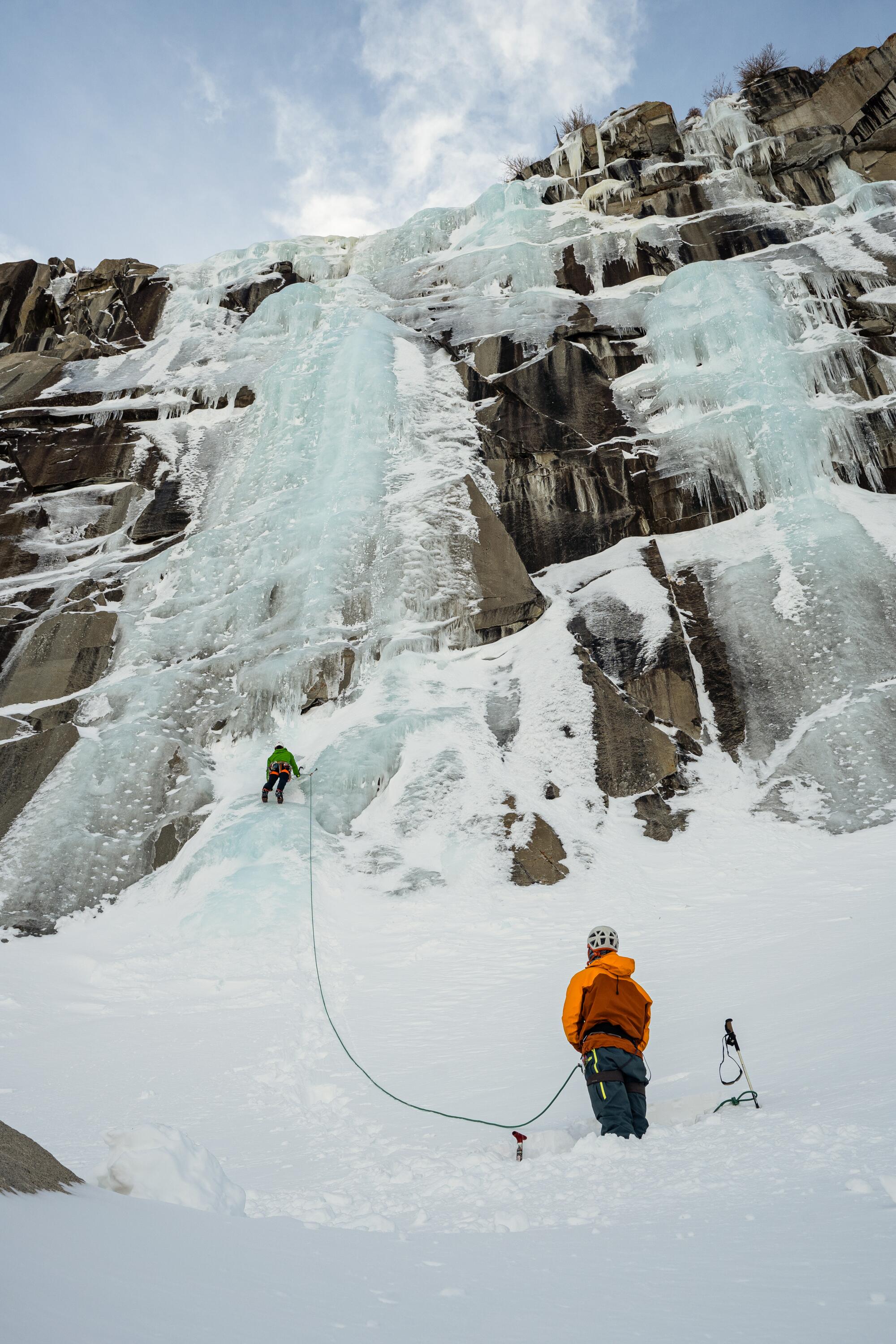
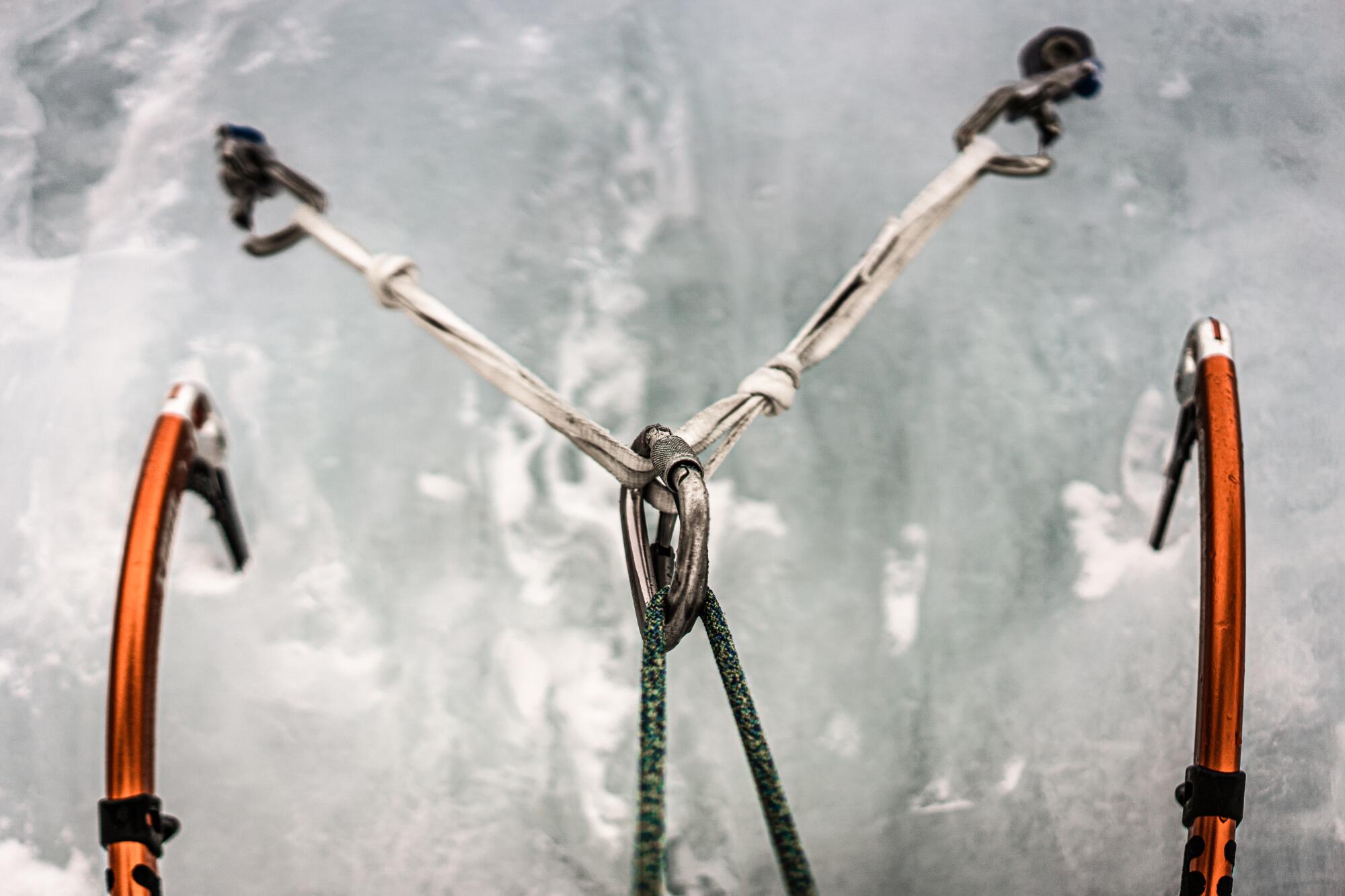
Besides group and individual instruction, guiding services generally provide all the goodies you need to ascend ice. If you’re connected to a rock-climbing or outdoorsy community, you may be able to borrow some gear. Some can be rented.
There are no requirements to book a beginner’s outing with Alpenglow, “just that you’re up for a day of adventure outside,” said Ballinger, an internationally recognized skier and climber. Private outings hover around $700 per person, he said. Alpenglow’s group intro courses in mountaineering, avalanche rescue and more start around $275.
The same goes for Sierra Mountain Guides, which offers a two-day introductory ice-climbing course. It costs $515 per person on weekends and $480 midweek. O’Connor said a full day of private guiding averages $500 or more.
While you don’t need to be an accomplished athlete, a basic level of fitness often is needed just to sojourn to the ice — particularly in parched California. Once you get there, you need enough energy to climb and then make the same trek back in a state of enhanced fatigue.
“You have to have some resilience and robustness to just withstand those elements alone. And then if you add in climbing and carrying all of your equipment … it’s definitely not for everyone,” O’Connor said. “I’m not saying that everyone shouldn’t try it, but not everyone’s gonna like it.”
A couple from the South Bay hiked from Mosquito Flats to Little Lakes Valley in Inyo National Forest in the Eastern Sierra Nevadas to get married in the most meaningful way.
As the rising sun spat fiery fuchsia across the sky, three companions and I caravaned to an unmarked trailhead near the eastern entrance to Yosemite National Park. Outfitted in rigid mountaineering boots, I hiked for 1½ hours over snow-covered boulders to reach the ice falls of Lee Vining Canyon.
Melinda Guerrero, 34, an experienced rock climber in my party who was trying ice for the first time, quickly calculated when we’d need to leave to avoid scrambling back after sunset. “I definitely don’t want to do that in the dark,” she asserted. My chafed heels whimpered in agreement.
Where to climb
It may not come as a complete surprise that California is not the ultimate destination for ice. That said, it’s home to several iconic ice playgrounds that are driving distance from the megalopolises of Los Angeles and San Francisco.
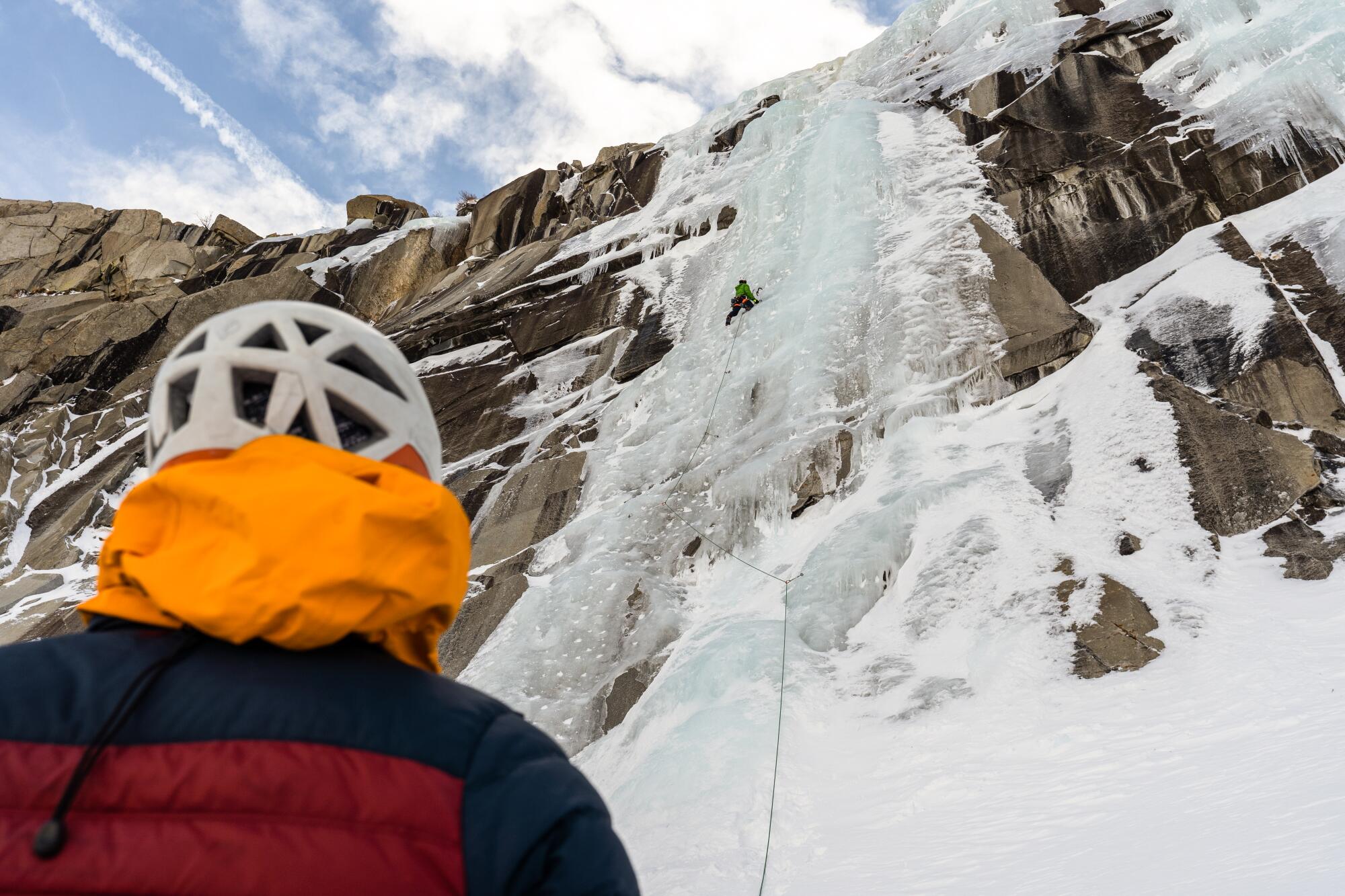
Eastern Sierra Nevada
- Lee Vining Canyon. Located near the small Eastern Sierra hamlet of Lee Vining, this area is arguably the best-known and most popular destination in the state. It lures climbers with its dependable ice that tends to linger during the winter. It also offers climbing routes suitable for beginners. Getting there isn’t a walk in the park: The trek to get there, known as the approach, involves navigating talus fields and steep passages that may be blanketed in snow.
- June Lake. This mountain community near Mammoth offers exponentially more accessible roadside ice. As the name suggests, ice seekers need only pull over along the June Lake Loop and walk a short distance to a crag with relatively low-angle ice ideal for learning on. Horsetail Falls is another popular spot that can be hiked to.
Northern Sierra Nevada
Ballinger’s guiding company typically brings clients to two zones in the Tahoe area:
- Donner Summit. Considered a Lake Tahoe rock-climbing “jewel,” the high pass located off I-80 draws ice climbers in colder months.
- Coldstream Canyon. Situated outside Truckee, the climbing area is more than six miles from the parking area, according to a blogger’s trip report.
Because of Tahoe’s heavy snowfall, Ballinger said the climbs become shorter as powder builds up and covers the routes.
Beyond California
Dedicated climbers converge in areas better known for ice, such as Cody, Wyo.; Ouray, Colo.; Hyalite Canyon near Bozeman, Mont.; Valdez, Alaska; and Canmore in the Canadian Rockies.
When to climb
Ice-climbing season in sunny California tends to be short and, yes, ephemeral. It typically runs from December through March in the Eastern Sierra but is highly dependent on weather conditions.
Tahoe’s season this year started in mid-November and Ballinger anticipates it will last through January, with a possibility of extending through February or March.
It’s critical to gauge the condition of the ice before getting on it. Sierra Mountain Guides posts handy ice reports.
When I visited the Eastern Sierra in mid-December, the temperatures were unusually warm. It made for more comfortable climbing (i.e., neither my fingers or toes screamed in pain) but less favorable ice conditions.
Four teeth of sharpened steel--the front points of his crampons--were all that supported Jim Gaines 80 feet up an ice cube.
Clothing considerations
What distinguishes ice climbing from many other other winter sports is that it involves relatively long periods of inactivity. While one person climbs, another waits below (or above) and belays them. This trade-off of movement and pause makes a clothing layering system particularly important.
The person who isn’t climbing generally throws on a heavy jacket and warm gloves. The outer jacket is shed while climbing and often gloves will be swapped for ones that allow for more dexterity. If the walk to and from the ice wall is long or strenuous, it’s important that you can strip off layers when you inevitably heat up.
Bringing “four pairs of gloves is not uncommon,” O’Connor said.
A note on danger
Shards of ice whizzed past me on a deviously slick platform underneath frozen waterfalls that resembled lofty ice sculptures. One thumped my hand, as if to say, “Outta my way!”
“They didn’t tell you about this part?” asked Jake Ballard, observing my consternation amid the onslaught. Ballard, 42, an experienced rock climber, recently started to tackle ice.
Actually, I had been told that one of the hazards of ice climbing is falling frozen debris. But I mistakenly assumed that ice would only plummet occasionally. (Later, I saw Ballard belaying a friend while he crouched behind a ridge to avoid the ice’s flight path.)
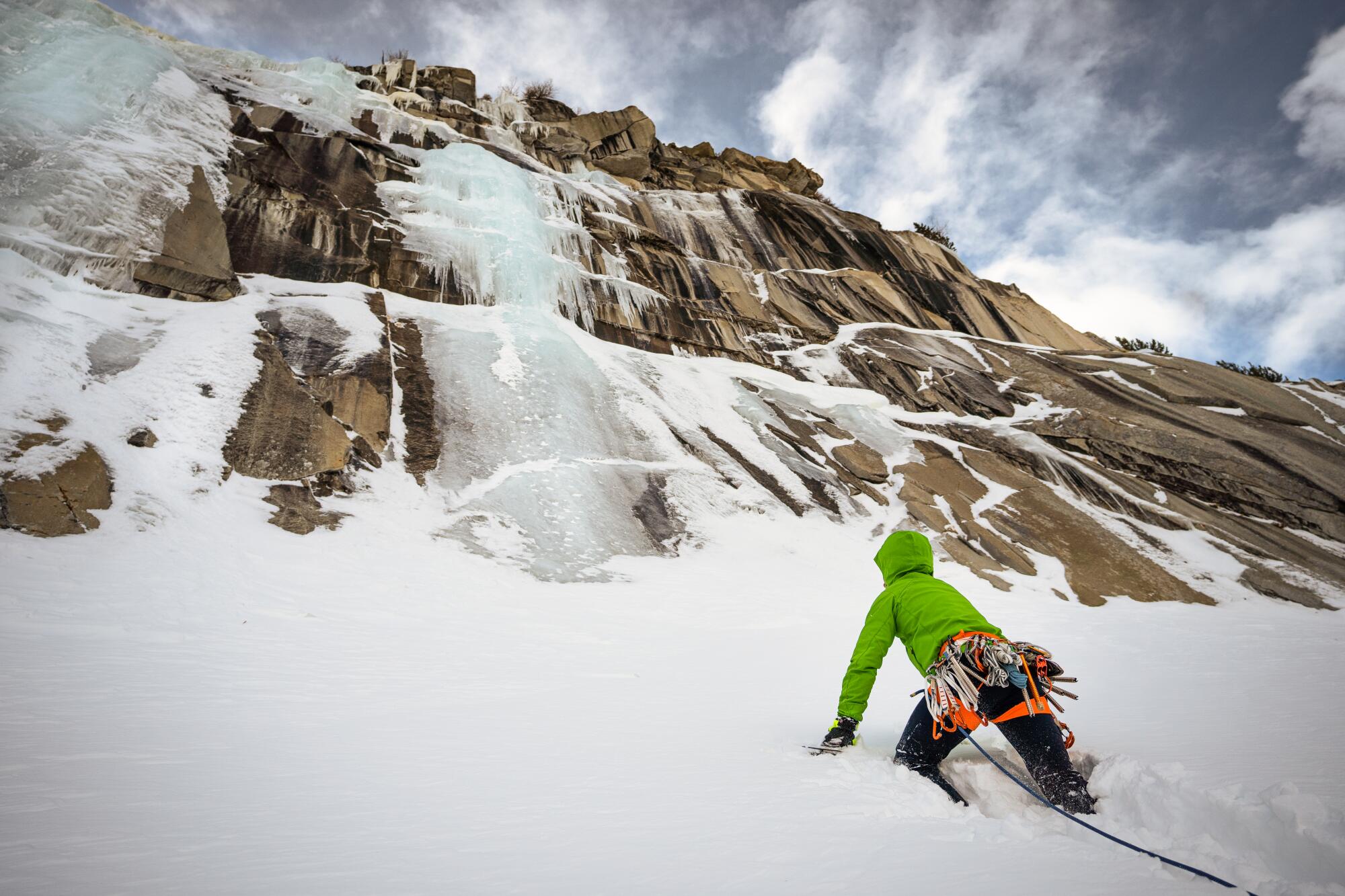
No activity conducted in the mountains is 100% safe, ice climbing included. Risks can be managed, minimized, but not entirely avoided.
Mountain experts generally agree that ice climbing is more dangerous than outdoor rock climbing. Avalanches, sharp equipment, cold weather and unstable ice all threaten bodily harm.
“If you’re in the wrong place at the wrong time, ice can fall and, if it hits you, there’s big enough pieces that it will kill you,” O’Connor said, adding that there are practices employed to position yourself to lower the likelihood of being hit.
There’s also a major difference between the risks posed by what’s known as leading and top roping a climb, both terms used in rock climbing. A person who leads a climb sets up the rope system that makes climbing safer for those who follow. They’re less protected on the first ascent and can suffer a serious fall. The person who climbs after the system is set up will be on top rope, which means that their partner should be able to catch them with minimal consequence if they fall.
Jones, who owns Sierra Climbing School, said the changing nature of the medium makes screws inserted into the ice to limit the distance the lead climber can fall “inherently suspect.”
“When you’re top roping … it’s just as safe as rock climbing as long as you’re not like stabbing yourself with a pick,” he said.
Climbing ice in a warming world
Climate change has made the evanescent sport more precarious. Increased heat doesn’t just shrink the available ice but threatens to make what does freeze unreliable.
Ballinger said climate change has shortened the season as lingering higher temperatures often delay the start before returning early in the spring to lop it off.
A spike in temperatures during the season can weaken the bonds of the ice and make it unsafe to climb. Once upon a time, Ballinger said they could reliably “run ice” consistently on weekends once the season started. Now fluctuations on the thermometer make it touch and go.
“In California, it’s always been ephemeral, but it’s even more so now,” he said.

More to Read
Sign up for The Wild
We’ll help you find the best places to hike, bike and run, as well as the perfect silent spots for meditation and yoga.
You may occasionally receive promotional content from the Los Angeles Times.


